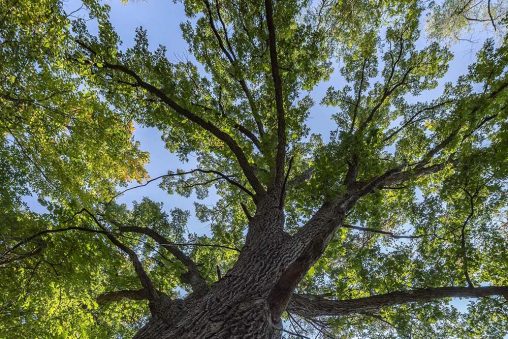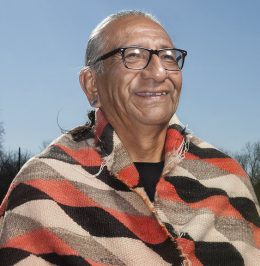
The fifth annual Runkle Woods Symposium on Nov. 18 will showcase research and artistic creations inspired by the Wright State campus woods.
How to protect the Wright State University woods, why the woods are valuable to the university community and how the woods inspire artistic creations are among the topics that will be explored during Wright State’s fifth annual Runkle Woods Symposium.
The Runkle Woods Symposium will take place on Friday, Nov. 18, from 1 to 5 p.m., in 101 Fawcett Hall. The event is open to students, faculty, staff and the public.
Research presented at the event will be available on Wright State’s CORE Scholar.
Featuring faculty, staff and students from the College of Science and Mathematics and the College of Liberal Arts, the annual Runkle Woods Symposium showcases research and artistic creations inspired by the Wright State campus woods.
The symposium is named after James Runkle, Ph.D., professor emeritus of biological sciences and a longtime woods researcher.
The Wright State University woods is 225 acres of forest that is home to up to 110 species of birds as well as foxes, coyotes, deer, salamanders and the rare Indiana bat.
A theme of this year’s symposium is how Wright State can protect the woods and value what it offers the community, said Audrey McGowin, Ph.D., professor and chair of the Department of Chemistry.
“What do we need to do to protect the woods and why are the woods valuable to us as a university?” she said. “It’s about the whole campus, it’s not just about what we do in science. It’s about how we all need and utilize and enjoy the woods.”
Hunkpapa Lakota Elder Guy W. Jones will deliver a keynote address on “Relationships for Humanity.”
Jones is a member of the Standing Rock Sioux Nation and a prominent voice for the Native American community in Ohio. He was part of the core committee to recognize Indigenous Peoples Day in Cincinnati. Jones is also a founder of the Miami Valley Council for Native Americans and has served as an advisor to the Cincinnati Museum of Natural History, the Minority Arts Task Force of the Ohio Arts Council, the Greater Dayton Christian Race Relations Task Force and the Bias Review Council of the Ohio Department of Education.
Students in McGowin’s Environmental Chemistry course will give a presentation on their research assessing the risk of road salt to trees in the woods.
“We’ll compare our data to past data, track trends, see what factors are affecting our data,” said chemistry major Mark Crockett.
Environmental Chemistry is a service-learning course, and in order to fulfill the service-learning aspect of the class, the students give a presentation to the public about their research. The course provided Crockett with his first opportunity to pursue research, which he described as a way to make a difference at Wright State and for the environment.
Runkle Woods Symposium schedule:
1–1:10 p.m.: Welcome and Introduction of Keynote Speaker
1:10–1:40 p.m.: Keynote Address “Relationships for Humanity,” Guy Jones
1:40– 2 p.m.: Discussion about conserving the woods, Volker Bahn
2–2:15 p.m.: “Assessing the Risk of Road Salt to Trees in the WSU Woods,” Shamal Chetty, Mark Crockett, Courtney Crone, Adebayo Djanman, Christopher Griesmeyer, Benjamin Kressbach, Brandon Noel, Israel Odoh, Jennifer Sally and Audrey McGowin
2:15–2:30 p.m.: “Venerable Trees of the Wright State Woods,” Don Cipollini
2:30–2:40 p.m.: “Biodiversity done the right way,” Brad Kerry
2:40–2:50 p.m.: “Bat Conservation in the Wright State Woods,” Heather Wilson, Morgan Hill, Riley Patrick, Rebecca Sanders and Daniel Upton
2:50–3 p.m.: “The Threat of Plant Invaders and the Plan to Reduce their Impact in the Wright State woods,” Brandon Thompson, Elizabeth Dunn and Tomee Norris
3–3:10 p.m.: “Drawing in the Woods,” Danielle Rante
3:10–3:30 p.m.: Break for refreshments, conversations and art viewing
3:20 p.m.: Hope Jennings Introduction of Student Group Presentations
3:30–3:40 p.m.: “A Travel Through Time: Exploring the History of the Wright State Woods,” Kaycie Bolin
3:40–3:50 p.m.: “Painting a White Picture: History of WSU Through Martin Rockafield,” Alexander Tischer
3:50–4 p.m.: “Place History: Campus Woods, Miami Valley, and Institutions of Colonialism,” Christian Sanders
4–4:10 p.m.: “The Parasitic Relationship Between the Woods and Wright State,” Aubrey Garman
4:10–4:20 p.m.: “Place History: The Easement,” Yasel Rosado
4:20–4:30 p.m.: “The ecosystem value of the dominant native and invasive shrubs in the WSU woods,” Jaedynn Duell and John O. Stireman III
4:30–4:40 p.m.: “Stormwater Bioretention through the Establishment of Native Wetland Flora,” Spencer Thomas, Davis Taylor and Elise Berry
4:40–4:50 p.m.: “Pollution and Littering: Land and Water Pollution Control in the Wright State Woods,” Alyssa Vanwinkle, Heidi Orloff, Madelynn Mitchell, Samuel Jackson and Josh Hivner
4:50–5 p.m.: Send-off meditation by Marie Thompson


 Milling around
Milling around  Wright State recognizes Nursing Professor Kim Ringo for advancing international student success
Wright State recognizes Nursing Professor Kim Ringo for advancing international student success  Wright State honors graduating students for distinguished doctoral dissertations
Wright State honors graduating students for distinguished doctoral dissertations  Top 10 Newsroom videos of 2025
Top 10 Newsroom videos of 2025  Museum-quality replica of historic Hawthorn Hill donated to Wright State
Museum-quality replica of historic Hawthorn Hill donated to Wright State 